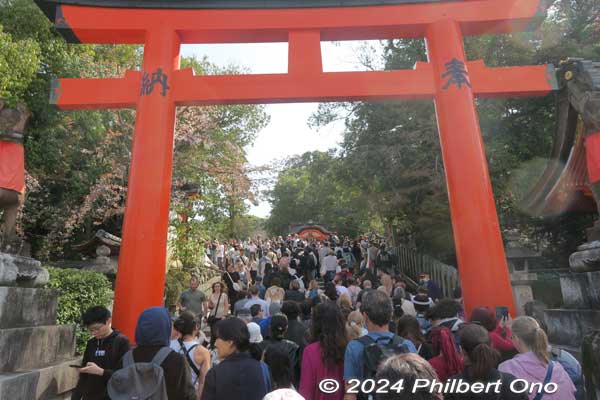
Japan is seeing record numbers of foreign tourists ever since Japan fully reopened to overseas tourists in Oct. 2022. The pent-up demand for Japan together with the favorable currency exchange rate and cherry blossoms have brought hordes of tourists from overseas.
Here are some photos of how crowded Japan can be when it’s busy. Something to take into consideration when planning a trip to Japan during peak seasons (late March to early April and mid- to late November). All taken in March–April 2024 during a cherry blossom tour.🌸
Tokyo
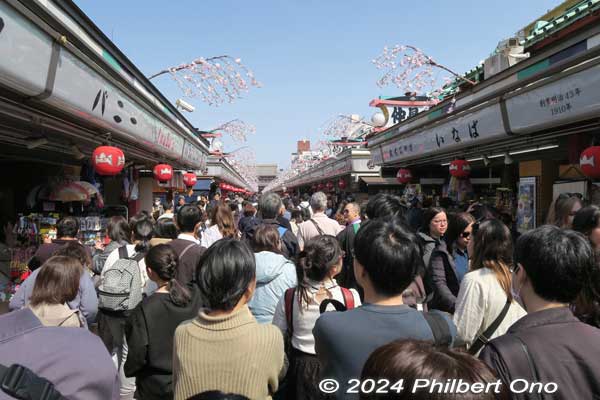
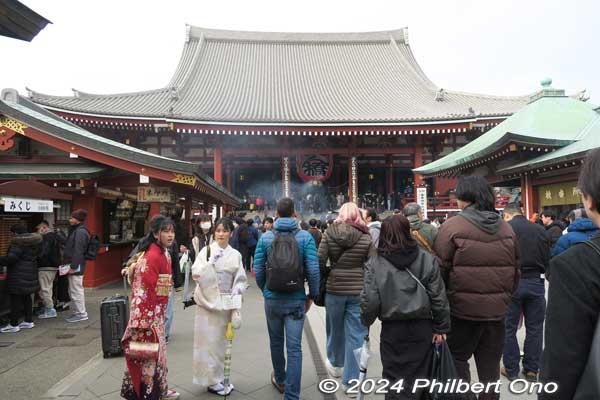
Asakusa is always crowded year-round. Nakamise shopping arcade (left) leading to Sensoji Temple (right). More photos…


Tsukiji Outer Market remains popular even after the famous fish market moved to Toyosu. The problem with Tsukiji is the roads and alleys are narrow within a relatively small rectangular area. There are sit-down sushi restaurants, but it may be crowded. A bowl of fresh sashimi (raw fish) on rice costs around ¥3,000 to ¥4,000. Finger food and take-out are quicker and cheaper. It’s less crowded toward the rear of the area. More photos…

Often times, you have to wait in line to have breakfast at your hotel. Less crowded before 7:00 am and after 8:30 am.


Left: Line for Tokyo Tower’s down elevators. More photos…
Right: Line to board the pirate boat at Lake Ashi in Hakone, Kanagawa Prefecture. Capacity 500 passengers. More photos…
Kanazawa, Ishikawa Prefecture

Tourists were delighted at the cherry blossoms in full bloom in mid-April at Kanazawa Castle. The castle had few spots (stone walls) damaged by the Jan. 1, 2024 Noto Peninsula earthquake. Otherwise, the building (long corridor) was open as usual. More photos…


Kenrokuen Garden next to Kanazawa Castle also had many cherry blossoms in full bloom. One of Japan’s Big Three Famous Gardens centering on a pond. More photos…

Quite a few overseas tourists are not used to taking off their shoes when visiting inside traditional buildings in Japan. It can be a real chore if you have problems kneeling or squatting.
When in Japan, best to wear shoes that are easy to take off and put on. Often times you have to put your footwear in a plastic bag and carry it with you since there’s not enough room at the entrance like this place which is the Nomura-ke samurai residence in Kanazawa.
Kyoto


Left: Kyoto Station, the gateway to Japan’s overtourism zone.
Right: Local buses in Kyoto are typically crammed with tourists, squeezing out the poor locals. If at all possible, riding the subway or train in Kyoto is better, but they are few.


All these people are going to the same place we’re going to…
Kinkakuji Gold Pavilion. Mostly overseas tourists on group tours, speaking most major languages of the world. Crowded, but they move along soon enough. More photos…

Many or most foreign tourists travel by chartered tour bus. One thing good about Kinkakuji is that it has a big parking lot for tour buses nearby.


Arashiyama was just crawling with tourists like ants on a trail of syrup. This alley (left photo) leads to the bamboo grove, while the main drag (right) has narrow sidewalks. If you stop and stand on the sidewalk, shopkeepers will shout at you to “Move on!” “Don’t stand here!” Tourists do have the tendency to just stop in the middle of the sidewalk or path where people are walking through.


They are here to see the sakura. Bamboo grove full of people taking selfies.

Entering Fushimi Inari Shrine‘s main torii in the morning full of people. More photos…


Entering the torii tunnel only to inch along inside. This is worse than New Year’s Day. I got out soon after this.


Miyako Odori cherry blossom dance signboard near the Kobu Kaburenjo Theater in Kyoto where the geisha dance is held in April by Gion geisha/geiko and maiko. It’s a colorful dance performed by 30 to 40 geisha/maiko three times a day. They sing, dance, and play Japanese instruments. Highly recommended if you’re in Kyoto in April.
https://miyako-odori.jp/english/
After the geisha show, the Hanamikoji road (right photo) from the theater in Gion is crowded with people and cars.

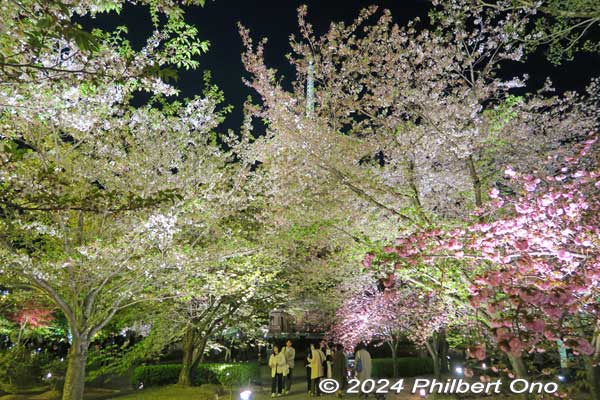
In the evening, went to Toji Temple (東寺) not far from Kyoto Station to see the enchanting illumination. The huge weeping cherry blossoms (left) was over, but the Somei-Yoshino was still pretty. This is the pagoda you might see from the shinkansen train when arriving Kyoto Station.
So beautiful, and a nice change of pace from daytime Kyoto. We could also enter the temple hall and see the Buddha statues. Well worth the ¥1000 admission.
Osaka


Osaka Castle also had a surprisingly long line to get in.
Also in Osaka, Dotonbori canal with the famous Glico marathon man LED billboard. Better to come here at night. More photos…


Dotonbori in Osaka is for foodies if you don’t mind the crowds. More photos…
Dotonbori also had this boat publicizing Osaka Expo 2025 next year with the weird-looking mascot. World exposition being built on an artificial island in Osaka Bay. Not much public enthusiasm yet.
https://www.expo2025.or.jp/en/
Himeji Castle, Hyogo Prefecture

Himeji Castle (White Heron Castle) is famous for cherry blossoms, attracting a great many tourists by the busload. It’s Japan’s largest and grandest castle. Original structures are National Treasures and a World Heritage Site.


Long line to get tickets to enter Himeji Castle. Takes maybe 30 min. to buy tickets. Tour guides should note that there is a shorter line to buy tickets and separate entrance for tour groups.


But there was a line to enter the castle. Lines even inside Himeji Castle’s main tower. If you don’t mind waiting in line, you can climb several flights of steep wooden stairs to reach the top floor for nice views. Not good if you have slippery socks, tight clothing, miniskirt, or weak/inflexible knees/legs.

Himeji Castle’s steep stairs. Views from the top are nice though. More photos…
Hiroshima

Atomic Bomb Dome. You can walk around it. Very sad place for all, especially for people like me with ties to both Japan and America.


Sometimes there’s a long line to buy tickets to enter Hiroshima Peace Memorial Museum. This took 30 min. to buy tickets. But at another time, it was quick.

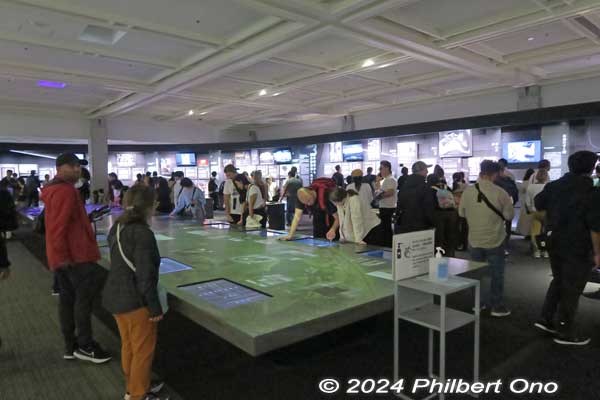
Inside Hiroshima Peace Memorial Museum jammed with people. More photos…

Miyajima also crowded. Big torii in the ocean is one of Japan’s Big Three Scenic Spots. More photos…


Left: Long line to buy tickets to enter Itsukushima Shrine on Miyajima, but tour groups could enter through a different entrance on the right.
Right: The shopping arcade on Miyajima was also crowded. Only finger food for lunch.


Ferry to Miyajima island and the ferry terminal on Miyajima. Ferries run often to/from Miyajima, so the crowd is not a problem. 15-min. ride.

As you can see, Japan has become a very popular tourist destination. Many people find it clean and safe. Food is good, cherry blossoms are beautiful, Japanese gardens are like giant bonsai, and people are polite.
It’s understandable that first-time visitors still gravitate to the most famous places from Tokyo to Hiroshima. To avoid the crowds though, visit the less popular places which are just as beautiful and interesting. The Tohoku Region, San’in Region, Shikoku, and Kyushu. Or maybe on a second trip to Japan. The rural and less crowded areas are much more enjoyable and adventurous.🌸